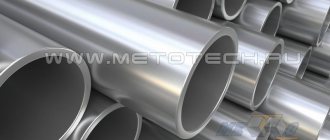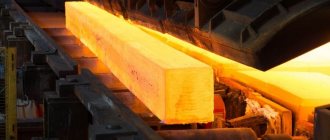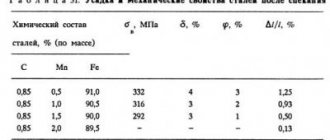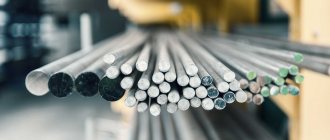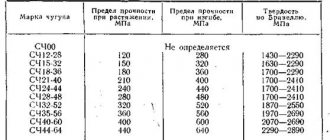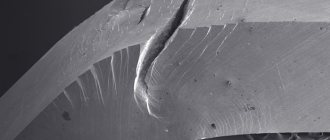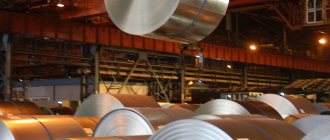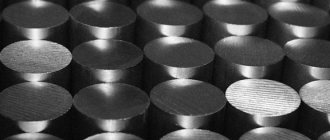Optical emission spectral analysis of C, S, P.
Optical emission spectrometers are universal instruments that can solve a wide range of analytical problems. Their work is based on the principles of atomic emission spectral analysis of the elemental composition of matter:
- the spectrum of excited atoms and ions is individual for each element;
- the intensity of the spectral line depends on the concentration of the element in the test sample.
Emission spectral devices are widely used in metallurgy, due to the following advantages of the method:
- Possibility of studying samples in different states of aggregation.
- The analysis is non-destructive.
- The number of elements studied is practically unlimited. These include carbon, sulfur and phosphorus, which are of particular interest to metallurgists.
- To conduct a test, a small amount of a substance is sufficient as a sample.
- High sensitivity and accuracy.
- Expressiveness.
- Possibility of conducting certification analysis.
To analyze carbon, sulfur and phosphorus using emission spectrometers, certain conditions must be created in the device, namely: an oxygen-free atmosphere. Otherwise, it is not possible to determine elements whose wavelength is shorter than 185 nm. Currently, oxygen removal in the device is carried out in two ways:
- by pumping with inert gas;
- vacuuming.
Each deoxygenation system has certain operating and maintenance features, so when choosing a device for analyzing carbon, sulfur and phosphorus, their advantages and disadvantages should be taken into account. This will allow you to select a spectrometer that optimally matches the analytical task, the requirements for the accuracy of research results, and has satisfactory economic indicators.
Optical emission devices involving pumping with inert gas
Argon is most often used in spectral instruments for deoxygenation. To remove oxygen, one of the following systems is provided:
- Open. As a result of purging, oxygen is displaced, and inert gas is removed from the device into the surrounding atmosphere.
- Closed. When the inert gas passes through, oxygen is captured, which is subsequently purified using a filter. The gas continues to move through a closed system, the pressure in which is provided by the pump.
Devices with an open deoxygenation system are characterized by simple design and lower cost. However, in this case, the degree of purification is at a low level, and argon is consumed irrevocably. The use of such spectrometers is advisable when requirements for analytical characteristics are reduced, both on the part of the consumer and on the part of the manufacturer.
The design of devices with a closed deacidification system becomes more complicated, since additional components and their maintenance are required to ensure functionality:
- Pump with power supply.
- Gas cylinder to compensate for losses.
- Additional filter element.
Each of these instrument components requires maintenance and consumables require replacement, which is associated with additional costs. In addition, as a result of unprofessional actions of maintenance personnel, there is a risk of air in the system when replacing the filter. Eliminating the consequences of this requires not only additional material costs, but also time.
Optical emission devices with a vacuum system
The vacuum system allows to obtain a low residual oxygen concentration, which is many times lower than in an open deoxygenation system and comparable to the best results obtained in closed ones. It should be noted that there is no need to use inert gas.
This oxygen removal system is used in the most advanced spectral instruments. They are equipped with an oil pump, which is complemented by special oil traps. In addition, a valve is provided that, in the event of an emergency power outage, prevents damage to the spectrometer by oil as a result of its penetration into the vacuum line.
Two-stage oil foreline pumps are the most preferred equipment compared to oil-free diaphragm models. They have a comparable cost, but at the same time are tens of times superior to the latter in terms of oxygen removal, and also have a significant service life and are much easier to maintain.
Universal desktop and stationary spectrometers Iskroline 100/300 are excellent examples of devices in which a vacuum system is implemented to remove oxygen. They are capable of determining more than 70 elements, which include carbon, sulfur and phosphorus, with a detection limit of up to 0.0001%. The devices allow for quick and accurate spectral analysis of steels, and are characterized by high spectral resolution, high accuracy of measurement results and high quality manufacturing.
Characteristics of titanium-based alloys, metal properties and applications
Titanium was originally named "gregorite" by British chemist Reverend William Gregor, who discovered it in 1791. Titanium was then independently discovered by the German chemist M. H. Klaproth in 1793. He named it titan after the Titans of Greek mythology - "the embodiment of natural strength." It was not until 1797 that Klaproth discovered that his titanium was an element previously discovered by Gregor.
Titanium is a chemical element with the symbol Ti and atomic number 22. It is a shiny metal with a silvery color, low density and high strength. It is resistant to corrosion in seawater and chlorine.
The element is found in a number of mineral deposits, mainly rutile and ilmenite, which are widespread in the Earth's crust and lithosphere.
Titanium is used to produce strong light alloys. The metal's two most useful properties are corrosion resistance and its hardness-to-density ratio, the highest of any metallic element. In its unalloyed state, this metal is as strong as some steels, but less dense.
Physical properties of metal
It is a strong metal with low density, quite ductile (especially in an oxygen-free environment), shiny and metalloid white. Its relatively high melting point of over 1650 °C (or 3000 °F) makes it useful as a refractory metal. It is paramagnetic and has fairly low electrical and thermal conductivity.
On the Mohs scale, the hardness of titanium is 6. According to this indicator, it is slightly inferior to hardened steel and tungsten.
Commercially pure (99.2%) titanium has an ultimate tensile strength of about 434 MPa, which is similar to common low-grade steel alloys, but titanium is much lighter.
Chemical properties of titanium
Like aluminum and magnesium, titanium and its alloys immediately oxidize when exposed to air. It reacts slowly with water and air at ambient temperatures because it forms a passive oxide coating that protects the bulk metal from further oxidation.
Atmospheric passivation gives titanium excellent corrosion resistance almost equivalent to platinum. Titanium is able to resist attack from dilute sulfuric and hydrochloric acids, chloride solutions and most organic acids.
Titanium is one of the few elements that burns in pure nitrogen, reacting at 800°C (1470°F) to form titanium nitride. Due to their high reactivity with oxygen, nitrogen and some other gases, titanium filaments are used in titanium sublimation pumps as absorbers for these gases. These pumps are inexpensive and reliably produce extremely low pressures in ultra-high vacuum systems.
Common titanium-containing minerals are anatase, brookite, ilmenite, perovskite, rutile and titanite (sphene). Of these minerals, only rutile and ilmenite are of economic importance, but even these are difficult to find in high concentrations.
Titanium is found in meteorites and has been found in the Sun and M-type stars with surface temperatures of 3200°C (5790°F).
Currently known methods for extracting titanium from various ores are labor-intensive and expensive.
Production and manufacturing
Currently, about 50 grades of titanium and titanium alloys have been developed and used. Today, 31 classes of titanium metal and alloys are recognized, of which classes 1–4 are commercially pure (unalloyed). They differ in tensile strength depending on oxygen content, with class 1 being the most ductile (lowest tensile strength with 0.18% oxygen) and class 4 the least ductile (highest tensile strength with 0.40% oxygen). ).
The remaining classes are alloys, each of which has specific properties:
- plastic;
- strength;
- hardness;
- electrical resistance;
- specific corrosion resistance and their combinations.
In addition to these specifications, titanium alloys are also manufactured to meet aerospace and military specifications (SAE-AMS, MIL-T), ISO standards and country-specific specifications, as well as end-user requirements for aerospace, military, medical and industrial applications.
A commercially pure flat product (sheet, slab) can be easily formed, but processing must take into account the fact that the metal has a "memory" and a tendency to bounce back. This is especially true for some high-strength alloys.
Titanium is often used to make alloys:
- with aluminum;
- with vanadium;
- with copper (for hardening);
- with iron;
- with manganese;
- with molybdenum and other metals.
Areas of use
Titanium alloys in sheet, plate, rod, wire, and casting form find applications in industrial, aerospace, recreational, and emerging markets. Powdered titanium is used in pyrotechnics as a source of bright burning particles.
Because titanium alloys have a high tensile strength-to-density ratio, high corrosion resistance, fatigue resistance, high crack resistance, and the ability to withstand moderately high temperatures, they are used in aircraft, armor, naval vessels, spacecraft, and missiles.
For these applications, titanium is alloyed with aluminum, zirconium, nickel, vanadium and other elements to produce a variety of components, including critical structural members, firewalls, landing gear, exhaust pipes (helicopters) and hydraulic systems. In fact, about two-thirds of titanium metal produced is used in aircraft engines and frames.
Because titanium alloys are resistant to seawater corrosion, they are used for propeller shafts, heat exchanger rigging, etc. These alloys are used in housings and components of ocean surveillance and monitoring devices for science and the military.
Specific alloys are used in oil and gas wells and nickel hydrometallurgy for their high strength. The pulp and paper industry uses titanium in process equipment exposed to aggressive environments such as sodium hypochlorite or wet chlorine gas (in bleaching). Other applications include ultrasonic welding, wave soldering.
Additionally, these alloys are used in automotive applications, especially in automobile and motorcycle racing where low weight, high strength and stiffness are essential.
Titanium is used in many sporting goods: tennis rackets, golf clubs, lacrosse shafts; cricket, hockey, lacrosse and football helmets, as well as bicycle frames and components.
The influence of chemical composition on the mechanical properties of steel
Each chemical element that makes up steel affects its mechanical properties in its own way - improves or worsens.
Carbon (C), which is an essential element and is usually found in steel in the form of the chemical compound Fe3C (iron carbide), increases its content to 1.2%, increases the hardness, strength and elasticity of steel and reduces toughness and weldability. This also reduces machinability and weldability.
Silicon (Si) is considered a beneficial impurity and is introduced as an active deoxidizer. As a rule, it is contained in steel in small quantities (up to 0.4%) and does not have a noticeable effect on its properties. But when the silicon content is more than 2%, the steel becomes brittle and breaks during forging.
Manganese (Mn) is contained in ordinary carbon steel in small quantities (0.3-0.8%) and does not have a serious effect on its properties. Manganese reduces the harmful effects of oxygen and sulfur, increases the hardness and strength of steel, its cutting properties, increases hardenability, but reduces resistance to impact loads.
Sulfur (S) and phosphorus (P) are harmful impurities. Their content, even in small quantities, has a harmful effect on the mechanical properties of steel. A steel content of more than 0.045% sulfur makes the steel red-brittle, i.e. one that cracks when forged in a heated state. Steel is protected from red brittleness by manganese, which binds sulfur into sulfides (MnS). The content of phosphorus in steel is more than 0.045%, making the steel cold-brittle, i.e. easily broken when cold. Phosphorus somewhat improves the machinability of steel, as it promotes chip separation.
Niobium (Nb) improves the acid resistance of steel and helps reduce corrosion in welded structures.
Titanium (Ti) increases the strength, density and ductility of steel, improves machinability and corrosion resistance. Increases the hardenability of steel at low contents and decreases at high contents.
Chromium (Cr) increases strength, hardenability and heat resistance, cutting properties and abrasion resistance, but reduces the toughness and thermal conductivity of steel. The content of a large amount of chromium (in ordinary types of steel reaches 2%, and in special types - up to 25%) makes the steel stainless and ensures the stability of magnetic forces.
Molybdenum (Mo) increases the strength characteristics of steel, increases hardness, red resistance, and anti-corrosion properties. Makes it heat-resistant, increases the load-bearing capacity of structures under shock loads and high temperatures. It makes welding difficult because it actively oxidizes and burns out.
Nickel (Ni) increases toughness, strength and elasticity, but slightly reduces the thermal conductivity of steel. Nickel steels are easy to forge. The significant nickel content makes the steel non-magnetic, corrosion-resistant and heat-resistant.
Tungsten (W), forming solid chemical compounds in steel - carbides, sharply increases hardness and red-hardness. Increases the performance of steel at high temperatures, its hardenability, increases the resistance of steel to corrosion and abrasion, and reduces weldability.
Vanadium (V) provides fine-grained steel, increases hardness and strength. Increases the density of steel, as it is a good deoxidizer. Reduces the sensitivity of steel to overheating and improves weldability.
Cobalt (Co) increases heat resistance, magnetic properties, and increases impact resistance.
Aluminum (Al) is an active deoxidizer. Makes steel fine-grained, homogeneous in chemical composition, prevents aging, improves stampability, increases hardness and strength, and increases oxidation resistance at high temperatures.
Copper (Cu) increases corrosion resistance, yield strength and hardenability. Does not affect weldability.
For a comprehensive understanding and analysis of the processes occurring during alloying and deformation of steels, knowledge of the relationships between the chemical composition and mechanical properties plays an important role.
The purpose of this research is to study the complex effect of chemical composition on the yield strength σT of reinforcing steel of class A500C
.
During September and October of this year, samples of reinforcing bars with a diameter from Ø16 to Ø36 were tested in the Laboratory for Testing Building Materials and Structures of the State Budgetary Institution “TsEIIS”. More than 30 parallel tests were performed. At the same time, for the same sample of a given standard size of reinforcing bars, the actual mass fraction of chemical elements was determined using a PMI-MASTER SORT optical emission spectrometer (Fig. 1) and the mechanical properties of steel using an IR-1000M-auto testing machine (Fig. 2 ).
Fig. 1 - Testing a reinforcing bar to determine the chemical composition of steel.
Fig. 2 - Tensile testing of reinforcing steel.
To ensure the reliability of statistical conclusions and meaningful interpretation of research results, the required sample size was first determined, i.e. minimum number of parallel tests. Since in this case the tests are carried out to assess the mathematical expectation, then with a normal distribution of the value under study, the minimum required volume of tests can be found from the relationship:
where υ is the sample coefficient of variation,
tα,k – Student coefficient,
α=1-P – significance level (P – confidence probability),
k = n-1 – number of degrees of freedom,
ΔМ – maximum relative error (tolerance) when estimating the mathematical expectation in fractions of the mathematical expectation (ΔМ = γ*δМ, where γ is the general coefficient of variation, δМ is the maximum error when estimating the mathematical expectation in fractions of the standard deviation).
As a rule, the general coefficient of variation γ is unknown, and it is replaced by the sample coefficient of variation υ, to determine which we conducted a series of ten preliminary tests.
Based on the results of the tests and calculations performed with a confidence probability of P = 0.95, the required sample size was obtained equal to n = 26
. The actual number of tests, as mentioned above, was 36.
The array of data obtained from the results of parallel tests was processed using multivariate correlation analysis.
The multiple regression equation can be represented as:
Y = f (β, X) + ε,
where X=(X1, X2,…, Xm) – vector of independent (initial) variables; β – vector of parameters (to be determined); ε – random error (deviation); Y – dependent (calculated) variable.
The development of a multiple correlation model is always associated with the selection of significant factors that have the greatest impact on the outcome trait. In our case, three elements (Al, Ti, W) were excluded from further consideration due to their low mass fraction (
If you find an error: select the text and press Ctrl+Enter
High manganese austenitic steels
Carbides containing molybdenum dissolve at a higher temperature than carbides of the (Fe, Mn)3C type, therefore austenitization of 110G13L steel with molybdenum is carried out at temperatures not lower than 1150°C. When the content of molybdenum in steel 110G13L is higher than the optimal value (0.3-0.5%), undissolved carbides appear in the structure in greater quantities, the more molybdenum is contained in the steel. The presence of carbides impairs the ductility and toughness of steel.
Considering the high cost of molybdenum, it is used for alloying 110G13L steel in rare cases for the manufacture of critical castings used in harsh conditions with exposure to intense shock and abrasive loads at low temperatures.
2.5 Niobium
The main goal of alloying 110G13L steel with niobium, as well as structural building steels, is to obtain a small austenite grain size and the resulting high values of yield strength, ability to strain hardening and, consequently, wear resistance during abrasive wear, reliability and durability of castings from this steel. One of the features of high-manganese steel with niobium is the high sensitivity of its physical and mechanical properties to deviations from the optimal chemical composition. The optimal content in high-manganese steel is considered to be 0.25–0.40% Nb. Optimal additions of niobium lead to a decrease in the size of the austenite grain, and in the cast state they help cleanse the grain boundaries from the carbide network. In high-manganese steel, 0.3–0.4% Nb increases the temperature at which softening begins during plastic deformation at elevated temperatures by approximately 200 °C.
Good results have been obtained by jointly alloying steel with niobium and chromium.
2.6 Titan
Additional microalloying and modification of high-manganese steel with various elements, according to a number of researchers, is one of the promising ways to significantly improve all its properties. One of these elements is titanium, which, like vanadium and niobium, belongs to the group of strong carbide formers. Titanium is introduced into high-manganese steel to increase its wear resistance, refine the structure during primary crystallization, eliminate the zone of columnar grains and improve the mechanical characteristics of castings, although there are conflicting opinions on the effect of titanium on the crystallization process.
So, according to research by Yu.A. Shults and other researchers, the addition of titanium to steel type 110G13L in an amount of 0.03-0.10% promotes significant grain refinement as a result of a significant increase in the number of crystallization centers in the form of finely dispersed refractory titanium nitrides and carbonitrides. This, in turn, leads to a noticeable increase in the crack resistance of steel, improvement in its mechanical properties and wear resistance. So, according to research by Yu.A. Schulte and other researchers, the addition of titanium to steel type 110G13L in an amount of 0.03-0.10% promotes significant grain refinement as a result of a significant increase in the number of crystallization centers in the form of finely dispersed refractory titanium nitrides and carbonitrides. As a result of a study of the influence of titanium on the properties of low-phosphorus steel type 110G13L, it was found that titanium additives contribute to an intensive increase in abrasive wear resistance, cold resistance and improvement of mechanical properties. Wear resistance improves especially noticeably with the simultaneous introduction of titanium and aluminum. The influence of titanium content on the impact strength and wear resistance of 110G13L steel, as well as on the grain size of castings. It has been established that when 0.05–0.2% Ti is introduced into steel, its impact strength increases slightly (by 0.35–0.50 MJ/m2 at 20 °C and by 0.20–0.25 MJ/m2 at - 40 °C (Fig. 2.3).
Rice. 2.3. The influence of titanium content on the impact strength of steel 110G13L.
With a further increase in titanium content, the impact strength of steel continuously decreases. Deterioration in the impact toughness of steel containing titanium in excess of the optimal amount (0.05-0.2%).
Conducted laboratory studies, industrial tests and observations, analysis of literature data indicate the advisability of introducing up to 0.20% Ti into steel type 110G13L to eliminate or significantly weaken the process of formation of a coarse-grained columnar structure of castings, increase the impact strength and wear resistance of this steel, despite a slight increase metal contamination with finely dispersed refractory titanium-containing non-metallic inclusions.
2.7 Bohr
The effectiveness of the influence of boron among numerous additives to steel at small additions is exceptionally high and, taking into account the specific values, exceeds the effectiveness of the influence of all other known elements. In addition, boron is a good deoxidizer and degasser of steel. The mechanism of boron influence has not been precisely established due to its low content.
Based on research, it can be considered that 0.0015 - 0.0030% B is equivalent in effect and can replace 1% Ni or 0.3% Cr; 0.10 - 0.15% Mo; 0.05 - 0.12% V, etc. Boron, as a surface active element that forms an adsorption layer on the austenite grain boundary, reduces the diffusion permeability of the grain boundaries of steels of the same compositions in relation to iron and can impede the dissolution of carbides during quenching.
The effect of boron on manganese steel was studied by the authors at its content equal to 0.003-0.050%. Boron was introduced into the deoxidized steel in the form of ferroboron (12.5% B). Its loss was about 50%. Boron additives had no effect on the change in the total gas saturation of the metal. Impact strength is significantly reduced by the presence of 0.0054% B in the steel. Increasing the boron concentration to 0.010–0.050% leads to a deterioration in strength and ductility due to the appearance of complex boron-containing eutectic at grain boundaries and grain enlargement. With such a boron content, samples made of high-manganese steel failed brittlely even at normal temperatures.
2.8 Nitrogen
The interstitial solution-forming element nitrogen is a strong austenitizing agent in steel and has attracted much research attention in the last twenty years. Being an analogue of carbon, nitrogen can in some cases successfully replace it. The positive properties of nitrogen as an alloying element in chromium austenite include its ability to create significant strain hardening and stabilize austenite when heated. The wear resistance of steel with chromium-nitrogen austenite 0Kh18A1.2 during abrasive wear exceeds the wear resistance of steel 120G18L by 10-15%. The partial replacement of carbon with nitrogen in 110G13L steel is therefore not only of scientific, but also of practical interest.
Depending on the composition and purpose of the metal, the effect of nitrogen on the properties of steel can be either positive or negative. Nitrogen has a positive effect on the primary crystallization of castings. The solubility of nitrogen in manganese is significantly higher than in iron. Therefore, with an increase in manganese in steel, the solubility of nitrogen in it will also increase. Nitrogen is introduced into steel in the form of nitrided ferroalloys (ferrochrome, ferromanganese) containing 1.5-7.0% N. The maximum absorption of nitrogen is about 0.3%. The authors introduced nitrogen into 110G13L steel in the form of manganese nitride to a nitrogen content in the metal of 0.34 to 0.435%. The impact strength of samples alloyed with nitrogen at all test temperatures is lower than for samples with a normal amount of nitrogen. The wear resistance of steel increases with an increased nitrogen content by approximately 12-15%.
When certain elements are introduced into steel, for example vanadium and chromium, etc., the solubility of nitrogen in the metal increases. Joint alloying of manganese steel with nitrogen and chromium (about 2%) significantly increases the yield strength and tensile strength without reducing ductility. The impact strength at all test temperatures is the same as that of samples alloyed with chromium alone or nitrogen alone.
2.9 Aluminum
In the practice of producing high-quality steels, aluminum is known primarily as a good deoxidizer (significantly reduces the residual oxygen content in the metal) and modifier (reduces grain size, as well as the composition, shape and arrangement of non-metallic inclusions).
Aluminum is one of those elements whose effect on high-manganese steel is assessed by different researchers from opposing positions. Most of the authors of the works (Yu.D. Novomeysky, Yu.A. Schulte, R.Z. Kats and N.A. Samarin and others, consider the introduction of aluminum into high-manganese steel in excess of the amount necessary for its final deoxidation, unjustified, since aluminum causes a deterioration in the mechanical properties, as well as the wear resistance of high-manganese steel, and is even harmful.
The positive effect of aluminum on the mechanical and operational properties of high-manganese steel, especially with a high phosphorus content, is evidenced by another group of studies. The plastic properties are especially significantly improved. Thus, when up to 1.1% Al is introduced into steel, the relative elongation and contraction increase approximately 4 times.
When analyzing the influence of aluminum on the mechanical properties and wear resistance of high-manganese steel, it is necessary to proceed from the contradictory features of its behavior in a solid solution, as a non-carbide-forming element, and its role as a deoxidizer and modifier.
Due to the positive effect of aluminum on the fluidity of well-decoxidized steel 110G13L, for the production of thin-walled castings, when increasing the fluidity of the metal is required, it is allowed to have 0.08-0.15% of residual aluminum in the steel.
Consequently, the amount of aluminum introduced into steel should be regulated by its need for the final deoxidation of the metal and the phosphorus content of this metal.
2.10. High carbon manganese steels
with metastable austenite
The change in microhardness over the cross-section of samples after concentrated impact loading with a striker sharpened at an angle of 60 degrees, which is struck by a load weighing 5 kg from a height of 2 m, is illustrated in Fig. 2.1, from which it can be seen that the level of hardening, measured by the increase in microhardness in the notch zone (H50), increases with increasing carbon content in steels. This dependence is explained by the fact that the degree of metal resistance to the penetration of the striker is proportional to the effective microhardness, which consists of the initial microhardness (H0) and its increase upon impact (∆H).
Rice. 2.4 Change in microhardness depending on the distance from the bottom of the notch of samples during a concentrated impact:
1 - 110G13L; 2 - 145G4L; 3 - 160G2L.
A higher level of hardening of the working surface of samples of metastable manganese austenitic steels from the standpoint of structural-energy theory is a consequence of the increased energy intensity of the surface layer, in which part of the energy of abrasive particles is spent on the formation of deformation martensite. As a result, a secondary structure of the surface layer is created with increased strength and dissipative ability, the penetration of particles into which occurs to a smaller depth, and chips are removed from a shallower depth, with the additional development of γ α transformation at the destruction stage (phase X-ray diffraction analysis of chips obtained during testing of samples steel 130G5L, showed the presence of 60% α - martensite).
The impact strength of steels 130G5L—160G2L after hardening from 1150°C is only 0.2—0.5 MJ/m2, which does not allow their use for castings operating under intense impact loads, however, they can significantly increase the durability of castings subjected primarily to abrasive wear and made from steels 80GSL, 100GSL after normalization, the impact strength of which is even lower. When using steels with a reduced manganese content, it is necessary to keep in mind that these steels have a smaller “austenitic reserve”, i.e., less not only deformation stability, but also less thermal stability of austenite compared to steel 110G13L. Therefore, it is important to ensure minimal decarburization of castings during heating during quenching in order to avoid the formation of cooling martensite in the surface layer, and intensive cooling to prevent the transformation of austenite in the center of the castings.
3. Thermal stability of austenite and its influence on the abrasive wear resistance of steels of the Fe—Mn—C system
During the process of slow cooling of castings, austenite decomposes in the structure of 110G13L steel with the release of carbides, which causes a catastrophic decrease in impact toughness. For wear-resistant castings, steel with a reduced carbon content is sometimes used instead of 110G13L steel.
Dilatograms of samples of medium-carbon steels 40G13L, 60G13L, 70G13L have a smooth character without sharp kinks associated with abrupt changes in volume during phase transformations, in contrast to high-carbon steels 95G13L and 125G13L. Only at temperatures of 500 - 600°C is a subtle bend associated with the processes of carbide formation in medium-carbon steels noticeable.
The dependence of the effective diffusion coefficient of carbon in austenite on temperature and carbon concentration is determined by the equation
Dc = (0.04 + 0.08% C) x (-1.31 RT) x 10-4 3.1
As a result of increasing the carbon content from 0.4 to 0.95%, the value of impact strength increases due to the increase in the stability of austenite with respect to the formation of martensite by cooling and deformation when the samples are tested in the quenched state. The same dependence after slow cooling of steels changes to the opposite due to a decrease in the thermal stability of austenite with an increase in its carbon content. The values of impact toughness of 70G13L steel after slow cooling (about 0.7 MJ/m2) are insufficient in most cases of using castings under impact loading conditions due to the fact that a noticeable volume of precipitated carbides and the metastability of austenite predetermine the low energy intensity of destruction under dynamic bending conditions. For the same steel, the largest number of martensitic phases appears on the working surface after slow cooling. A noticeable amount of the carbide phase after slow cooling is fixed in steels starting from 0.7% C and naturally increases with increasing carbon content in the steel. This leads to the fact that the average carbon content in the solid solution of high-carbon steels after slow cooling (95G13L and 125G13L) is close to that for medium-carbon steels (60G13L and 70G3L) and amounts to 0.5-0.65%.
Cast manganese steels after slow cooling have an uneven concentration of carbon and manganese within the austenite grain due to dendritic segregation and uneven occurrence of austenite decomposition processes. The chemical microinhomogeneity of austenite after slow cooling causes unequal stability of different volumes of cast metal.
The wear resistance of steels during abrasive wear depends not so much on the initial hardness, which increases after slow cooling to a greater extent, the higher the carbon content in the steel, but on the level of effective strength that is achieved in the surface layer of steels during exposure to abrasive particles. A decrease in the carbon content in the solid solution reduces the ability to strengthen the austenitic-martensitic structure and, as a consequence, reduces the level of wear resistance of steels compared to the hardened state, despite the presence of the carbide phase.
Impurities: permanent, hidden and random
Manganese, silicon, aluminum, sulfur and phosphorus
classified as
permanent impurities
.
Aluminum, together with manganese and silicon, is used as a deoxidizer and therefore they are always present in small quantities in deoxidized steels. Iron ores, as well as fuels and fluxes, always contain a certain amount of phosphorus and sulfur, which remain in cast iron and then pass into steel
.
Nitrogen
called
a hidden
impurity - it enters steel mainly from the air.
To random
impurities include
copper, arsenic, tin, zinc, antimony, lead
and other elements. They end up in the steel with the charge - with ores from various deposits, as well as from iron scrap.
All impurities - permanent, hidden and accidental - are inevitable to varying degrees due to steel production technology. Thus, mild steel usually contains these impurities within the following limits: 0.3-0.7% manganese; 0.2-0.4% silicon; 0.01-0.02% aluminum; 0.01-0.05% phosphorus, 0.01-0.04% sulfur, 0.-0.2% copper. In these quantities, these elements are considered as impurities, and in larger quantities, which are intentionally added to steel, they are already considered alloying elements.
The influence of phosphorus on the properties of steels
Phosphorus (P) segregates during steel solidification, but to a lesser extent than carbon and sulfur. Phosphorus dissolves in ferrite and thereby increases the strength of steels. As the phosphorus content in steels increases, their ductility and toughness decrease and their tendency to cold brittleness increases.
The solubility of phosphorus at high temperatures reaches 1.2%. With decreasing temperature, the solubility of phosphorus in iron drops sharply to 0.02-0.03%. This amount of phosphorus is typical for steels, that is, all phosphorus is usually dissolved in alpha iron.
Phosphorus has a strong tendency to segregate at grain boundaries, resulting in temper brittleness in alloy steels, especially in manganese, chromium, magnesium-silicon, chromium-nickel and chromium-manganese steels. Phosphorus, in addition, increases the hardening of steels and, like silicon, slows down the decomposition of martensite in steels.
Increased phosphorus content is often specified in low-alloy steels to improve their machining, especially automatic machining.
In low-alloy structural steels with a carbon content of about 0.1%, phosphorus increases strength and resistance to atmospheric corrosion.
In austenitic chromium-nickel steels, phosphorus additions help increase the yield strength. In strong oxidizers, the presence of phosphorus in austenitic stainless steels can lead to grain boundary corrosion. This is due to the phenomenon of phosphorus segregation along grain boundaries.
Properties of electrical steel
Changes associated with the addition of silicon improve the properties of electrical steel:
- The higher the electrical resistivity, the greater the ability of the material to prevent the passage of electric current. This reduces its losses and prevents the formation of eddy currents, which cause heating of the core and electrical protective devices.
- The soft magnetic ferroalloy from which transformers, generators, controllers, relays, and transmitters are made must have a low coercive force. For steel, which is used for the production of magnetic circuits, cores and magnets, the highest possible. The coercive force value shows the strength of the external magnetic field, which leads to complete demagnetization of the steel. It is increased by increasing the silicon content.
- The hysteresis loop is characterized by its width. The wider it is, the more time it will take for the electrical components to restore their original parameters. As the width decreases, the time period for restoring the original values and relieving mechanical stress decreases.
- Magnetic permeability characterizes the ability of the magnetic moments of electrons to orient in parallel when exposed to an external magnetic field. An increase in the magnetic permeability coefficient leads to a decrease in eddy current losses and a decrease in the hysteresis loop. The coefficient depends on the magnitude of the external magnetic field.
- The thickness of produced transformer steel sheets varies from 0.05 to 2 mm.
The listed properties ensure reliable operation of electrical parts made of ferroalloy and increase their service life.
The influence of sulfur on the properties of steels
The sulfur (S) content in high-quality steels does not exceed 0.02-0.03%. In general purpose steels, the permissible sulfur content is higher - 0.03-0.04%. By special treatment of liquid steel, the sulfur content in steel is brought to 0.005%.
Sulfur does not dissolve in iron, so any amount of it forms iron sulfide FeS with iron. This sulfide is part of the eutectic, which is formed at 988 °C.
An increased sulfur content in steels leads to their red brittleness due to low-melting sulfide eutectics that arise along grain boundaries. The phenomenon is red
brittleness occurs at a temperature of 800 °C, that is, at the
red-hot
of steel.
Sulfur has a detrimental effect on the ductility, toughness, weldability and surface quality of steels (especially in steels with low carbon and manganese content).
Sulfur has a very strong tendency to segregate at grain boundaries. This leads to a decrease in the ductility of steels in the hot state. However, 0.08 to 0.33% sulfur is deliberately added to steels for automatic machining. It is known that the presence of sulfur increases the fatigue strength of bearing steels.
The presence of manganese in steel reduces the harmful effects of sulfur. In liquid steel, the formation reaction of manganese sulfide occurs. This sulfide melts at 1620 °C - at temperatures much higher than the temperature of hot working of steels. Manganese sulfides are plastic at temperatures of hot processing of steels (800-1200°C) and therefore are easily deformed.
The effect of titanium in stainless steel
The ennobling effect of titanium on steel is expressed in the removal of oxygen, iron and manganese oxides, nitrogen bubbles and slag inclusions, and in preventing the segregation of structural components of the metal and harmful impurities.
Complete reduction is achieved and the remaining carbon, phosphorus and sulfur are distributed more evenly and finely. As a result, the steel acquires a fine-grained structure with a more uniform dispersion of carbides, phosphides and sulfides and greater density with the least amount of pores, oxides and slag inclusions. The production of a homogeneous, compact, bubble-free ingot distinguishes these steels favorably from steel obtained without titanium purification. Steels deoxidized by titanium have increased mechanical properties: strength, elastic limit, resistance to tearing, tension and compression, malleability, ability to process and weld. The amount of defects is reduced and the quality of casting and rolled products is improved. When making rails from titanium-killed Bessemer steel, the amount of defects is reduced by 15-20%, the elastic limit doubles, and the service life increases by two to three times. The addition of ferrocarbotitanium to sheet steel improves the quality of finishing sheets, giving them an even, smooth surface without pores or stains.
Titanium steels . Adding up to 3% titanium to steel significantly increases its hardness. The high hardness of titanium carbides was used for the manufacture of superhard alloys, which made it possible to obtain titanium high-speed steels.
Titanium imparts increased corrosion resistance to steel and improves the properties of steel castings. Adding titanium to stainless steels increases their weldability.
Titanium steels, in addition to iron, usually contain from 0.3 to 9% Ti, 0.1–0.8% C, 0.1–0.5% Mn, 0.04–0.5% Si, 0.01–0 .03%' P and up to 0.025% S. The mechanical properties of steel depend not only on the titanium content, but also on the carbon and manganese content. Thus, with increasing titanium and carbon content, the hardness and strength of steel increase, while with increasing manganese content, hardness and strength decrease, although in many cases the effect of manganese content is not so dramatic.
The mechanical properties of titanium steels of various compositions are given in Appendix 40.
Alloys of titanium with other metals
Copper alloys. Alloying titanium alloys with copper increases their stability during operation and also increases heat resistance. The solid solution of β-titanium alloys with copper is not fixed during hardening, as a result of which a process that increases the fragility of the alloy, which is possible when the solution decomposes, is eliminated, and thermal resistance is increased.
Copper-rich alloys are called cuprotitanium. Cuprotitanium is used in the purification of molten copper, acting as a deoxidizer and denitrogenizer and helping to remove slags. For this purpose, cuprotitanium containing titanium from 5 to 12% is used. His
Source
The influence of aluminum on the properties of steels
Aluminum (Al) is widely used for deoxidation of liquid steel, as well as for grain refinement of steel ingots. The harmful effects of aluminum include the fact that it promotes the graphitization of steels. Although aluminum is often considered an impurity, it is also actively used as an alloying element. Because aluminum forms solid nitrides with nitrogen, it is usually an alloying element in nitrided steels. Aluminum increases the resistance of steels to scaling, and therefore it is added to heat-resistant steels and alloys. In dispersion-hardening stainless steels, aluminum is used as an alloying element that accelerates the dispersion precipitation reaction. Aluminum increases the corrosion resistance of low-carbon steels. Of all the alloying elements, aluminum is the most effective for controlling grain growth when heating steels for hardening.
The influence of nitrogen on the properties of steels
The harmful effect of nitrogen (N) is that the rather large, brittle non-metallic inclusions it forms - nitrides - worsen the properties of steel. A positive property of nitrogen is that it is capable of expanding the austenitic region of the phase diagram of steels. Nitrogen stabilizes the austenitic structure and partially replaces nickel in austenitic steels. Nitride-forming elements vanadium, niobium and titanium are added to low-alloy steels. When controlled by hot working and cooling, they form fine nitrides and carbonitrides, which significantly increase the strength of the steel.
The dual properties of titanium metal
Many people are interested in the slightly mysterious and not fully studied titanium - a metal whose properties are somewhat ambiguous. Metal is both the strongest and most fragile.
The strongest and most fragile metal
It was discovered by two scientists with a difference of 6 years - the Englishman W. Gregor and the German M. Klaproth. The name titan is associated, on the one hand, with the mythical titans, supernatural and fearless, and on the other hand, with Titania, the queen of fairies. This is one of the most common materials in nature, but the process of obtaining pure metal is particularly complex.
Properties of titanium
22 chemical element of D. Mendeleev's table Titanium (Ti) belongs to group 4 of period 4.
The color of titanium is silver-white with a pronounced shine. Its glare shimmers with all the colors of the rainbow.
This is one of the refractory metals. It melts at a temperature of +1660 °C (±20°). Titanium is paramagnetic: it is not magnetized in a magnetic field and is not pushed out of it. The metal is characterized by low density and high strength. But the peculiarity of this material is that even minimal impurities of other chemical elements radically change its properties. In the presence of an insignificant proportion of other metals, titanium loses its heat resistance, and the minimum of non-metallic substances in its composition makes the alloy brittle.
This feature determines the presence of 2 types of material: pure and technical.
- Pure titanium is used where a very light substance that can withstand heavy loads and ultra-high temperature ranges is required.
- The technical material is used where parameters such as lightness, strength and corrosion resistance are valued.
The substance has the property of anisotropy. This means that the metal can change its physical characteristics based on the force applied. You should pay attention to this feature when planning the use of the material.
Titanium loses strength at the slightest presence of impurities of other metals
Studies of the properties of titanium under normal conditions confirm its inertness. The substance does not react to elements in the surrounding atmosphere. Changes in parameters begin when the temperature rises to +400°C and above. Titanium reacts with oxygen, can ignite in nitrogen, and absorbs gases.
These properties make it difficult to obtain a pure substance and its alloys. Titanium production is based on the use of expensive vacuum equipment.
Titanium and competition with other metals
This metal is constantly compared to aluminum and iron alloys. Many chemical properties of titanium are significantly better than those of competitors:
- In terms of mechanical strength, titanium is 2 times greater than iron, and aluminum 6 times. Its strength increases with decreasing temperature, which is not observed among competitors. The anti-corrosion characteristics of titanium significantly exceed those of other metals.
- At ambient temperatures the metal is completely inert. But when the temperature rises above +200°C, the substance begins to absorb hydrogen, changing its characteristics.
- At higher temperatures, titanium reacts with other chemical elements. It has a high specific strength, which is 2 times higher than the properties of the best iron alloys.
- The anti-corrosion properties of titanium significantly exceed those of aluminum and stainless steel.
- The substance does not conduct electricity well. Titanium has an electrical resistivity 5 times higher than that of iron, 20 times higher than that of aluminum, and 10 times higher than magnesium.
- Titanium is characterized by low thermal conductivity, this is due to its low coefficient of thermal expansion. It is 3 times less than that of iron, and 12 times less than that of aluminum.
The influence of copper on the properties of steels
Copper (Cu) has a moderate tendency to segregate. The harmful effects of copper include a decrease in the cold brittleness of steel. With an increased copper content, it negatively affects the quality of the steel surface during hot processing. However, with a content of more than 0.20% copper increases its resistance to atmospheric corrosion, as well as the strength properties of alloy and low-alloy steels. Copper in amounts greater than 1% increases the resistance of austenitic stainless steels to sulfuric and hydrochloric acids, as well as their resistance to stress corrosion.
Phosphorus
Iron ores, fuels, and fluxes contain some amount of phosphorus, which during the production of cast iron remains in it to one degree or another and then turns into steel. Phosphorus dissolves well in ferrite and austenite, and at high content it forms phosphide Fe3P (15.62% P). Dissolving in ferrite, phosphorus distorts the crystal lattice and increases the strength and yield limits of steel, greatly reducing ductility and toughness; every 0.01% P increases the cold brittleness threshold by 20...25 0 C. Phosphorus is a harmful impurity in steels.
Like phosphorus, sulfur enters the metal from ores, as well as from furnace gases - a product of fuel combustion (SO2). Sulfur is very limitedly soluble in ferrite, and almost any amount of it forms a sulfur compound with iron - iron sulfide FeS, which is part of the eutectic, which has a melting point of 988 0 C. It is located mainly along the grain boundaries. When steel is heated to rolling or forging temperatures (1000...1200 0 C), the eutectic melts, breaking the bond between grains. During deformation, tears and cracks form in these places. This phenomenon is called red brittleness. The introduction of manganese into steel reduces the harmful effects of sulfur, since when it is introduced into liquid steel, manganese sulfide is formed, which has a melting point
FeS + Mn -> MnS + Fe.
MnS particles are located in the form of separate inclusions and, during deformation, are pulled into lines along the rolling.
Sulfur compounds greatly reduce the mechanical properties of steel under static and cyclic loading, especially toughness, ductility, and endurance limit. Sulfur is a harmful impurity in steels.
Features of titanium and its alloys
Today, titanium ranks 4th in terms of industrial use. However, its active extraction and production begins only in the 40s of the 20th century. Titanium and its alloys have unique characteristics and require more careful consideration in metalworking.
Titanium
Basic information
Titanium is a silver-colored metal that is included in group 4 of period 4 in the periodic table. According to official data, it ranks 10th in distribution in nature.
Initially, the metal was used in the national economy, but after its super strength and low specific gravity were discovered, titanium and its alloys began to be used in the construction of aircraft, ships, rockets and cars.
History of discovery
Titanium oxide was first discovered in 1791. This discovery was made by W. Gregor (English). He took a sample of ferruginous sand on a Cornwall beach and carried out research on it. As a result of experiments, the scientist isolated an oxide of an unknown metal, which he never gave a name. Another scientist called this element titanium - Martin Heinrich Klaproth (German). In 1825, another researcher, Jöns Jakob Berzelius, was able to isolate a sample of this metal from its oxide.
Production and manufacturing
Due to its prevalence in nature, mining ore containing titanium is not difficult. The most common types of ore that contain this metal are brookite, ilmenite, anatase and rutile. However, further processing of titanium (melting, hardening and aging) is considered expensive. There are several stages in obtaining pure metal from ore:
- First of all, titanium slag is extracted by heating ilmenite to 1650 degrees.
- Next, the slag goes through a chlorination process.
- After this, titanium sponge is produced using resistance furnaces.
- To obtain pure metal, the final processing step is the refining process.
If you need to obtain titanium ingots, a sponge based on it is melted in a vacuum furnace.
Advantages and disadvantages
Like any other metal, titanium has its strengths and weaknesses. Benefits include:
- light weight;
- corrosion resistance;
- resistance to high temperatures;
- high strength - greater than that of the best steels.
Flaws:
- Dust and chips remaining after processing titanium workpieces can ignite at a temperature of 400 degrees.
- This metal is difficult to weld and is practically impossible to cut.
- The costly method of obtaining metal from ore causes its high cost.
However, despite the existing disadvantages, the material and its alloys are widely used in various industries. Light weight
Titanium Products
In construction stores you can find a variety of products made from this metal. It is used to produce wire, tape and foil, rods, and pipes. You can also purchase titanium in solid sheets.
Application area
Due to the advantages that titanium has, it is used in various industries:
- naval affairs;
- construction;
- medicine;
- mechanical engineering;
- shipbuilding and aircraft manufacturing;
- chemical industry.
The peculiarities of the use of this metal make it more popular every year. It is actively used in the national economy.
Characteristics and properties
The characteristics of titanium directly depend on the amount of impurities contained in its composition. Physical parameters:
- Specific strength - 450 MPa.
- Melting point - 1668 degrees.
- Boiling point - 3227 degrees.
- The tensile strength of the alloys is 2000 MPa.
- The elasticity of titanium is 110.25 GPa.
- Metal hardness - 103 HB.
- The yield strength is 380 MPa.
Improving steel quality
To remove gases and non-metallic inclusions dissolved in it from liquid steel, vacuum treatment is used. To do this, a ladle with liquid steel is placed in a hermetically sealed chamber, where a vacuum of 267...667 Pa (2...5 mm Hg) is created. The rapidly released gases carry with them non-metallic inclusions and remove them from the metal. Within 10...15 minutes, the amount of dissolved gases decreases by 3...5 times, the number of non-metallic inclusions - by 2...3 times.
To protect the metal from oxidation, steel is cast in an inert atmosphere, for example, argon, under a layer of synthetic slag. To produce steels of particularly high quality, electroslag remelting (ESR), plasma arc remelting, electron beam remelting, and electric arc vacuum remelting are used. The metal is well cleaned (refined) from gases and non-metallic inclusions by treatment with slag and directed crystallization of the liquid melt, creating a deep vacuum.
Dear students! Our website specialists are ready to provide assistance in studying in various subjects: ✔ Solving problems ✔ Completing educational work ✔ Help with exams
